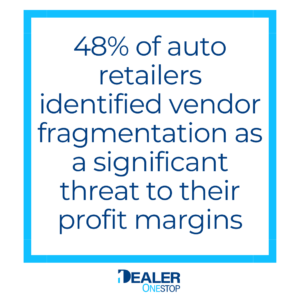An auto dealership often seems like a convergence point for a variety of vendor relationships. Various data sources, including expert insights from the National Automobile Dealers Association (NADA), peg the average number of vendors auto dealerships work with between 10 to 15. This gamut includes numerous small businesses catering to diverse needs within the dealership ecosystem. Yet, as necessary as these vendor relationships appear, they hide a tangled web of inefficiencies and adverse effects that dealerships often grapple with.
The sheer number of vendors creates a logistical nightmare for the administrative team. For a purchasing team functioning within these dynamics, every vendor brings a different set of invoices, purchase orders, and monthly account balances.
The Administrative Strain of High Vendor Counts
High vendor counts pose a logistical problem, not just adding to the intricacies of management but also significantly straining administration. Each vendor relationship comes with its own set of invoices, purchase orders, and differing monthly account balances.
For instance, the purchasing team, already tasked with a multitude of responsibilities, now needs to manage these myriad streams separately. Any efficiency deficit in this process not only stretches resources but also increases the probability of transactional errors. According to a study by Spend Matters, nearly 60% of businesses report that missed paperwork or overlooked documents have caused substantial delays in payment cycles. Delayed payments are just the tip of the iceberg, with ripple effects spreading far and wide within the organization’s financial ecosystem.
The toll this takes on the finance side of operations cannot be undermined. Accounting departments, often overwhelmed with consolidating multiple invoices for reconciliation, bear the brunt. As per recent surveys, over 25% of such departments express vendor fragmentation as a pressing issue siphoning their productivity.
Limited Visibility in Supply Chains with Many Vendors
Navigating through a myriad of vendor relationships can cast a cloud of ambiguity over a dealership’s supply chain visibility. When spending is diversified across 10-15 different suppliers, procurement teams often grapple with accurately gauging the total buying power.
A survey conducted by Procurement Leaders found that, due to this fragmented visibility, most large auto dealership groups are only utilizing their maximum spending leverage with their top 5 suppliers. Due to numerous vendors, visibility percolates, making negotiation strategies less effective and alliances fewer. Furthermore, limited line of sight diminishes the efficiency of investment strategies and hampers effective planning. In essence, dealerships are left in the dark regarding potential deals and fail to make the most out of bulk expenditure.
The higher the vendor count, the more the view of total procurement capability is obstructed. This ultimately leads to a value-weighted divide between what is possible in terms of negotiation and what is actually achieved.
The Quest for Coordinated Solutions
Understanding the problem is the first step toward finding a solution. Within a dispersed business model, perfectly coordinated answers to mitigate vendor-related issues may appear elusive. As long as solutions remain fragmented, profit risks will continue to lurk.
 For instance, a recent study by NADA and shared by Deloitte reported that 48% of auto retailers identified vendor fragmentation as a significant threat to their profit margins. As traditional vendor structures undermine fiscal performance, the urgency to adopt coordinated and efficient practices has never been more critical.
For instance, a recent study by NADA and shared by Deloitte reported that 48% of auto retailers identified vendor fragmentation as a significant threat to their profit margins. As traditional vendor structures undermine fiscal performance, the urgency to adopt coordinated and efficient practices has never been more critical.
As the quest for coordinated solutions ensues, many auto dealerships are considering procurement transformation. This involves shifting from standalone vendor channels to a more streamlined, centralized purchasing mechanism. Vendor consolidation, efficient contract management, and digital solutions are now at the center stage of strategic discussions.
It’s evident that a whole-system approach is necessary for substantial gains. Companies must intensify efforts to restrategize vendor relationships and redefine supply chain visibility. Only through these consolidated solutions can auto retailers hope to reduce administrative weights and see an upswing in fiscal health.
Redefining Vendor Relationships
In today’s demanding fiscal landscape, auto retailers cannot afford the operational burden of juggling many vendors. The necessity for a wide array of supplies stays significant. However, there is an escalating requirement to reassess the current vendor relationship configuration.
Engaging more comprehensive suppliers who can cater to various needs can lead to increased efficiencies for auto retailers. Such a holistic approach augments buying strength and tempers administrative weight. Ultimately, these changes promise to significantly improve the fiscal performance of the auto retail sector, rewriting the tried and tested dynamics of vendor relationships for the better.








